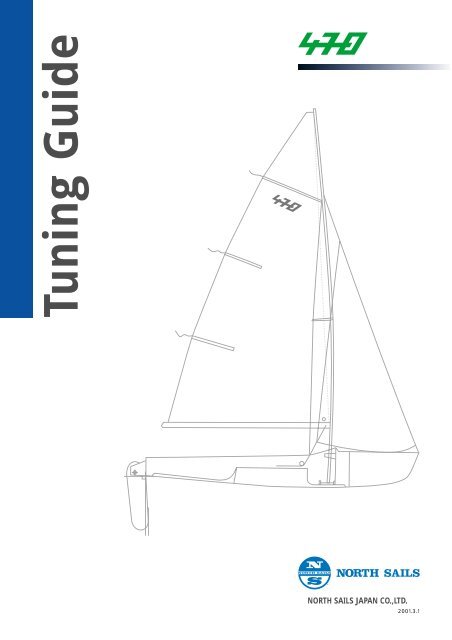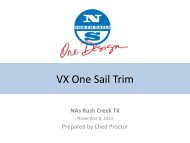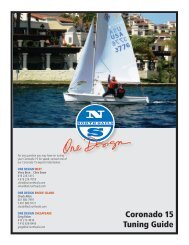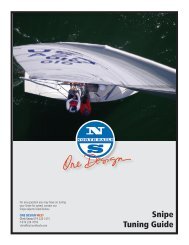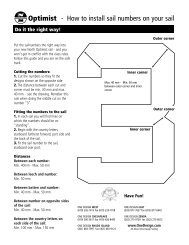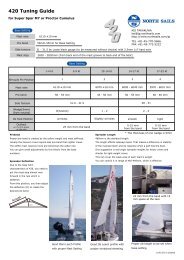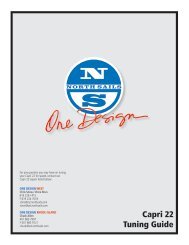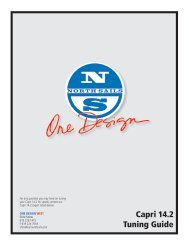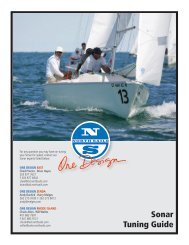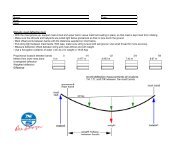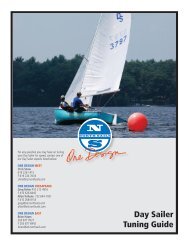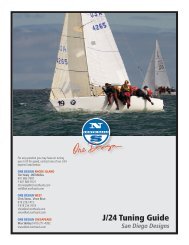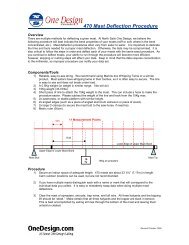470 Tuning Guide E01 - North Sails - One Design
470 Tuning Guide E01 - North Sails - One Design
470 Tuning Guide E01 - North Sails - One Design
You also want an ePaper? Increase the reach of your titles
YUMPU automatically turns print PDFs into web optimized ePapers that Google loves.
<strong>Tuning</strong> <strong>Guide</strong><br />
NORTH SAILS JAPAN CO.,LTD.<br />
2001.3.1
Equipment<br />
outhaul<br />
leech ribbon<br />
mast rake<br />
peak rope<br />
spreader<br />
rig tension<br />
(sidestay)<br />
main tack<br />
mast step position<br />
prebend<br />
tack rope<br />
mast puller<br />
mast step<br />
Before <strong>Tuning</strong>...<br />
rig tension<br />
(forestay)<br />
It`s important to tune the mast to get the<br />
best sail shape while sailing.For this reason,<br />
checking the boat settings is very<br />
important.It`s better to ensure mast is<br />
straight and in symmetry.The alignment<br />
and positioning of rudder and centerboard<br />
is also important.Otherwise you<br />
can`t get correct data.<br />
These data are for <strong>470</strong> sails produced in<br />
<strong>North</strong> <strong>Sails</strong> Japan Loft.You should consider<br />
these data as a guide to find your<br />
best settings according to your crew<br />
weight and type of masts.<br />
Mast Rake<br />
Mast rake will affect helm balance and sail<br />
force. When you feel overpowered, you<br />
should rake the mast aft to de-power. It<br />
makes less overlap between main and<br />
jib.Doing so will:<br />
1.increase mast bend<br />
2.reduce heeling moment<br />
3.balance helm from resulting flatter<br />
mainsail shape<br />
4.increase the forestay angle makes the<br />
forestay tighter<br />
But with too much aft-rake in full power<br />
condition,you will lose the power,speed<br />
and height.If your crew weight is light or<br />
you use a hard mast,you will meet<br />
overpowerd condition in lower range than<br />
standard,so you must rake the mast further<br />
aft and more earlier.<br />
To set up the mast to measure the rake,<br />
you should be using standard rig tension,<br />
the deck chock loose, and the tape measure<br />
at the mainsail maximum hoist<br />
position. The rake is measured to the top<br />
of the transom on the centreline.<br />
Wind Range 0~7m/s 7~9m/s 9m/s~<br />
Mast Rake 6720~<br />
6740mm<br />
6670~<br />
6690mm<br />
6630~<br />
6650mm<br />
For light weight team wanting to cover wide<br />
wind range with one setting,base setting is<br />
6700~6730mm.For heavy weight team wanting<br />
to get more power at lighter wind range,you<br />
should set mastrake as 6740~6770mm.Higher<br />
rake makes more power ,but also you will feel<br />
overpowerd earlier.<br />
Rig Tension<br />
Why is rig tension required?<br />
1.To transfer wind pressure of sails to the<br />
hull sensitively.<br />
2.Prevent forestay from sagging.<br />
3.To control the mast bend which affects<br />
the mainsail shape.<br />
If rig tension is loose,<br />
1.Unstable rig leads to loss of force.<br />
2.Jib sail will get deeper and attack angle<br />
will become wider which can reduce<br />
pointing.<br />
3.Can not control mast bend.<br />
*There are 3 types of tension gauges.Loose<br />
Model A (Plate:Left),Loose Model PT-1 Metric<br />
(Spring:Middle),Super Spars (Plate:Right).The<br />
tension unit number is all different.<br />
The average diameter of<br />
side stays is 3mm,and<br />
there is more twisted standard<br />
wire(1*19) and less<br />
twisted hard wire.Refer this<br />
chart,because numbers<br />
are all different.<br />
Loose APT-1<br />
Super<br />
Spars<br />
Tension Gauge Loose A PT-1 S.Spars<br />
Sidestay Standard 41~42 33~34 35~36<br />
Hard<br />
42~43 34~35 36~37<br />
Forestay (measure over 34~36 25~26 28~29<br />
the sail)<br />
Mast Step<br />
This position affects sail balance. When<br />
the mast step moves forward, it decreases<br />
pre-bend and increases overlap<br />
with jibsail. When mast step moves aft,it<br />
increases pre-bend and decreases overlap<br />
with the jib. The characteristic of the<br />
different boat designs affect the boat balance<br />
and therefore, the step position will<br />
be different from one boat builder to the<br />
next. The postion of the shroud base also<br />
affects where the step should be. Generally,<br />
if the shroud base position is forward,<br />
then the mast base should be at<br />
the forward position.<br />
Hull type<br />
Tiegel-mayer<br />
Mackay<br />
Devoti<br />
Navtivela<br />
Mast Puller<br />
Step Position<br />
3100 ±10mm<br />
3095 ±10mm<br />
3100 ±10mm<br />
3095 ±10mm<br />
This controls mast fore and aft bend. At<br />
full power sailing, the mainsail requires the<br />
deepest camber from the view point of<br />
lift. You should pull up to 20~30mm bend<br />
at spreader position, this is maximum<br />
puller. We set the puller in response to<br />
wind speed. You should provide big bend<br />
in flat water and small bend in rough water.<br />
In light conditions, you can use the puller<br />
to induce pre-bend to keep the ideal<br />
camber.<br />
Spreaders<br />
[Length]<br />
Spreader length can control mast sidebend.<br />
Spreader deflection can control<br />
mast fore and aft bend.<br />
Spreader setup has a close relation with<br />
crew weight. You should find the proper<br />
length from the table below.<br />
[Deflection]<br />
The deflection is the final measurement<br />
for mast tuning after the rig tension, mast<br />
step position and rake is set. You will find<br />
the deflection measurement at the<br />
spreaders to be between 130 mm and<br />
150 mm with no mast chock.<br />
Measurement:Set the Rig Tension as Sailing<br />
Condition and release the Puller,then measure<br />
the distance of (D).<br />
<br />
Mast type<br />
SUPER SPAR M7<br />
SUPER SPAR M7+<br />
Pre-bend<br />
Length<br />
<strong>470</strong>~490mm<br />
460~480mm<br />
For light weight (under 115kg) teams,you should try<br />
shorter than the above number.<br />
Pre-bend is defined by mast step<br />
position,spreader and rig tension.If prebend<br />
is small at light and heavy wind<br />
conditions,it results in loss of speed from<br />
too much deeper sail shape and less<br />
leech twist.(high drag & sideforce.)<br />
Appropriate pre-bend may be changed<br />
by stiffness of mast and crew weight.For<br />
a soft mast or heavy weight team,you<br />
should set a small pre-bend.For stiff mast<br />
or light weight team,you should set more<br />
pre-bend.<br />
Measurement:Mast Pre-bend is measured<br />
using a stringline on the aft face of<br />
the mast touching the back of the track<br />
at the mainsail luff black bands. The measurement<br />
position is at the spreader position.<br />
Mast Type<br />
SUPER SPAR M7<br />
SUPER SPAR M7+<br />
Prebend(A4) Prebend(A9)<br />
40~50mm<br />
50~60mm<br />
70~75mm<br />
75~80mm<br />
*These numbers are for regular mast rake.<br />
For light weight (under 115kg) teams,you should use<br />
more pre-bend than the above number according to<br />
your crew weight.
Main Sail<br />
Leech Ribbons<br />
The top Leech ribbon is sign of sail twist<br />
at under 4m/s condition.A ribbon flowing<br />
constantly means too much twist, and<br />
stall means too tight twist. You should<br />
control the leech to keep the top ribbon<br />
flowing at 50%~80% ratio (middle and<br />
bottom ribbon should be flying constantly).<br />
Outhaul<br />
Outhaul can be eased 10mm~15mm from<br />
inner black band under 0~5m/s condition.<br />
If you need power in bad wave<br />
conditions,the outhaul can be eased to<br />
10~25mm.Over 5m/s condition,when you<br />
feel overpowered a little,you should pull<br />
the outhaul to the black band.The mainsail<br />
tack should be touching the aft face of<br />
the mast when you are getting back<br />
wind.(refer to the section about the<br />
mainsail tack rope.)<br />
Cunningham<br />
When you pull the cunningham,the draft<br />
position will be moved forward and the<br />
leech will be opened giving a flatter<br />
shape.As the wind increases,there is a<br />
tendency that the draft will move aft.So<br />
you should pull the cunningham to get the<br />
proper draft position.In maximum wind<br />
condition,you must pull the cunningham<br />
harder until the ring is sitting near the tack<br />
position.<br />
Tack Rope<br />
Peak<br />
You should adjust the main halyard length<br />
so that the peak of mainsail(upper edge<br />
of head board) is the same height as<br />
lower edge of the mast top black band .<br />
Mainsail has cutback tack for more wider<br />
control of depth:<br />
fullpower -- set sail edge at tack 10 mm<br />
apart from backside of mast .<br />
overpower -- set sail edge at tack nearby<br />
the mast when backwind appears.<br />
It`s important that you<br />
should hoist the main<br />
halyard to this position<br />
for measuring mast<br />
rake.<br />
fullpower - set sail<br />
edge at tack 10 mm<br />
apart from backside of<br />
mast .<br />
overpower- set sail<br />
edge at tack nearby<br />
the mast when<br />
backwind appears.<br />
Tack Rope and Outhaul control<br />
Condition<br />
0m/s~Full Trapeze or just before<br />
(no vang)<br />
Full Trapeze ~ use some vang<br />
Boom is constantly out of boat<br />
Tack Rope<br />
(Mast side)<br />
10mm apart<br />
10mm apart<br />
0mm<br />
Outhaul<br />
(Black Band)<br />
ease 10~15mm<br />
pull until at the<br />
black band<br />
pull until at the<br />
black band<br />
Jib Sail<br />
Example<br />
Trim Line<br />
When Jib track position is right and you<br />
luff up the boat, all telltales will respond at<br />
the same time, because of effect of<br />
backwind at luff. Our sail includes a trim<br />
line which makes the lead angle easy to<br />
find up to full power sailing. This trim line<br />
shows proper track position when trim<br />
line and jib sheet is on the same line. This<br />
means good jib sail trim (middle batten is<br />
parallel to boat center line).<br />
The trim line supports your lead angle trim<br />
up to full power sailing. When you feel over<br />
power from increasing wind speed, you<br />
should move the track position aft in relation<br />
to sail power. It is necessary to open<br />
leech in accordance with<br />
keeping a proper slot between main and<br />
jib, because over-sheeting the jib causes<br />
the main boom to be eased too far in order<br />
to reduce heel. This means lower<br />
pointing.<br />
<strong>Tuning</strong> Data Example<br />
Wind range<br />
Mast rake<br />
0 0~4m/s 6750mm Light Wind Special<br />
1 0~6m/s 6720mm<br />
>1/2pin shorter<br />
2 7~9m/s 6690mm<br />
>1/2pin shorter<br />
3 9~10m/s 6660mm<br />
>1/2pin shorter<br />
4 10m/s~ 6630mm<br />
Full Power<br />
We define the Full Power Condition as the<br />
situation where we can keep the boat flat<br />
without the loss of wind power and hold<br />
the boom in the center with full trapeze.<br />
It`s important to tune the mast to derive<br />
as much thrust as possible.<br />
You should control the mast bend to deal<br />
with overpower and underpower condition.<br />
<br />
Peak Rope<br />
If you hoist the jibsail higher, it makes more<br />
gap between the sail foot and deck. Wind<br />
which flows under the jib foot is turbulent<br />
and causes loss of efficiency. You should<br />
adjust the peakrope so that the jib foot<br />
just touches the waterbreak at full power<br />
sailing. At this height, it makes the most<br />
effective sail area with end-plate effect of<br />
foredeck and less overlap of mainsail.<br />
Tack Rope<br />
<br />
You should use only light tension up to the<br />
middle wind range (4m/s). There should<br />
be almost no tension on the sail material<br />
behaind luff tape.Too much tension<br />
makes the entry angle too wide<br />
and can damage the material which has<br />
a biased orientation at this edge. In strong<br />
wind, try to keep the creases out of the<br />
luff.
Sail Trimming<br />
Trimming Table<br />
Wind range 0~2m/s 3~4m/s 4~7m/s 7~9m/s 9m/s over<br />
mast bend<br />
during sailing<br />
Best shape<br />
Best shape<br />
Same amount of bend<br />
Best shape<br />
but flatter<br />
Flat shape<br />
w/ more bend<br />
from mast rake<br />
Flatter<br />
w/more mast rake<br />
& more mast bend<br />
mast prebend<br />
A4<br />
A9<br />
50~60mm 40~30mm 30~20mm 30~65mm 60~90mm<br />
75~80mm 60~75mm 70~80mm 90~100mm 100mm~<br />
mast puller<br />
Maximum<br />
12m/s<br />
Ease according to<br />
windspeed<br />
main and jib<br />
leech tension<br />
Maximum<br />
vang tension<br />
no vang<br />
If you can't hold the<br />
boom in the center,<br />
use some vang<br />
As the wind<br />
increases<br />
use more vang<br />
Over 12m/s ease<br />
vang tension to<br />
depower mainsail<br />
cunningham<br />
no cunningham<br />
Pull wrinkes out of luff<br />
if you can't hold the boom<br />
in the center<br />
gradually pull<br />
Maximum<br />
outhaul<br />
clew in approximately 15mm.In waves,outhaul can be eased<br />
to 25~40mm.The mainsail tack should be 10mm from the<br />
aft face of the mast.<br />
As the wind increases, pull outhaul until at<br />
the black band. The mainsail tack should be<br />
touching the aft face of the mast.<br />
boom position<br />
3~ 4 boom widths to<br />
leeward of the<br />
centreline.<br />
centerline<br />
As the boat becomes overpowered,<br />
boom position is further to leeward side.<br />
jib track<br />
align the fairlead with the trimline<br />
3~8 cm aft of trimline if<br />
the boom is constantly<br />
off the centreline<br />
3~10 cm back from trimline<br />
position. Jib leech will open<br />
more with aft mast rake.<br />
jib tack<br />
wrinkles just removed from luff<br />
gradually pull<br />
pull tight<br />
Copyright<br />
NORTH SAILS JAPAN CO.,LTD.<br />
HEAD OFFICE / YOKOHAMA LOFT 4-3,SHIRAHO,KANAZAWA-KU,YOKOHAMA 236-0007 JAPAN<br />
Tel + 81- 45-770-5666 Fax + 81- 45-773-5222<br />
WWW<br />
http://www.northsails.com/jp/<br />
E-Mail<br />
info@jp.northsails.com


